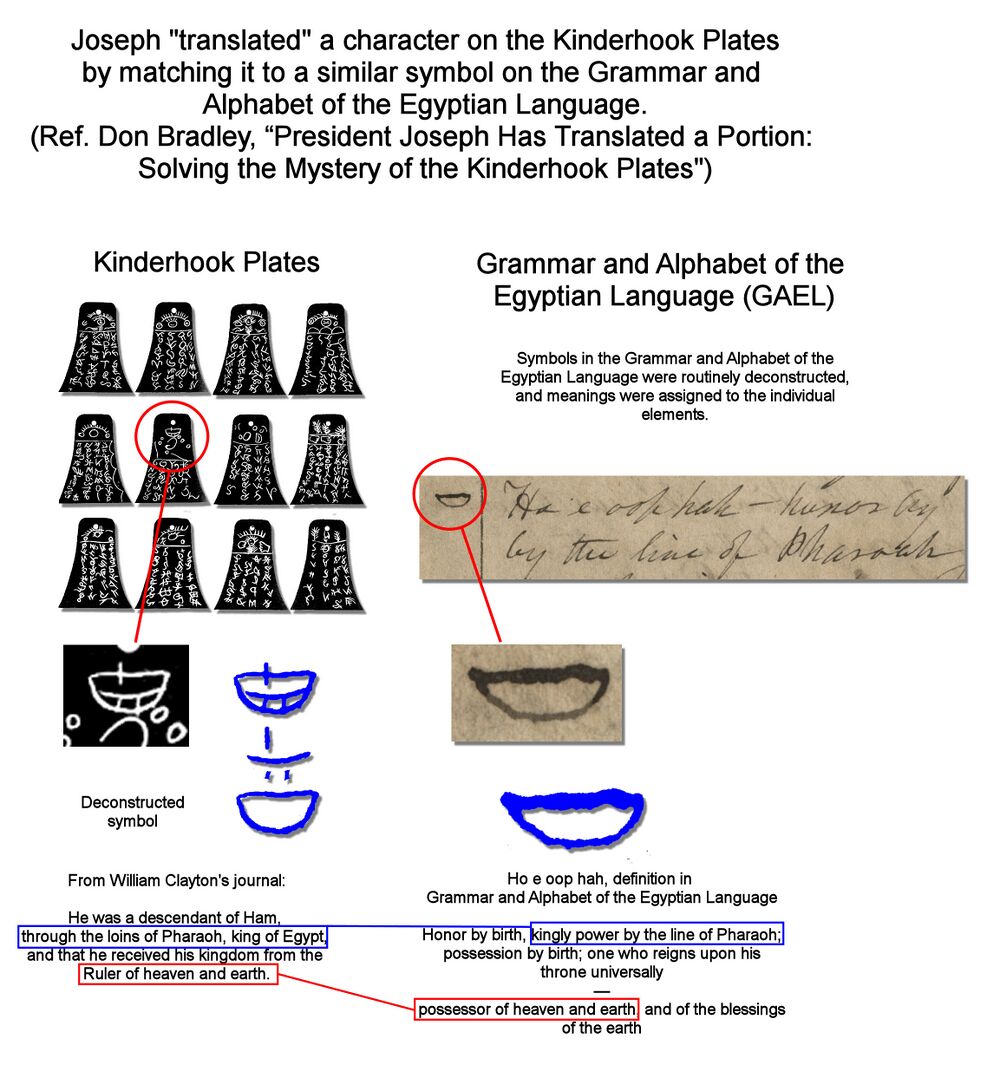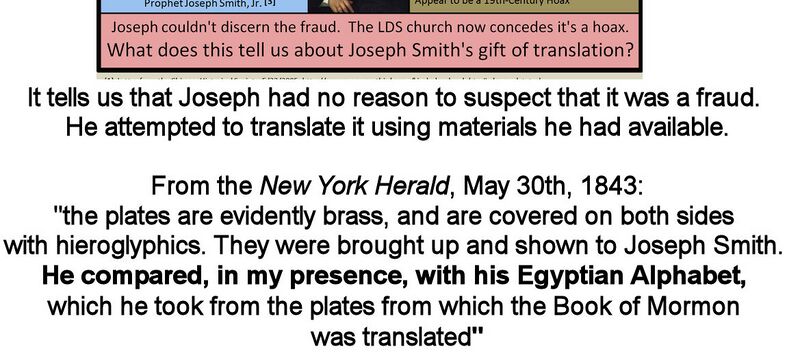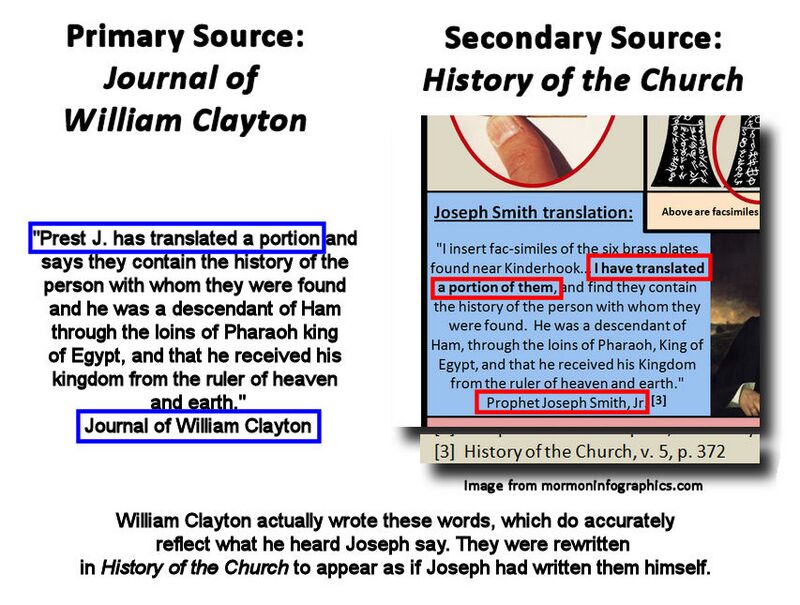
FAIR is a non-profit organization dedicated to providing well-documented answers to criticisms of the doctrine, practice, and history of The Church of Jesus Christ of Latter-day Saints.
(m) |
|||
| Line 104: | Line 104: | ||
[[File:Mormoninfographic.kinderhook.josephs.gift.jpg|800 px|thumb|center]] | [[File:Mormoninfographic.kinderhook.josephs.gift.jpg|800 px|thumb|center]] | ||
===Question:Why is the statement in ''History of the Church'' written as if Joseph said it?<br>Answer: ''History of the Church'' was written in the "first person" after Joseph's death=== | ===Question:Why is the statement in ''History of the Church'' written as if Joseph said it?<br>Answer: ''History of the Church'' was written in the "first person" after Joseph's death=== | ||
Given the evidence that the Kinderhook plates were fraudulent, how can one explain the following things?
To see citations to the critical sources for these claims, [[../CriticalSources|click here]]
Joseph Smith's personal secretary, William Clayton said,
President Joseph has translated a portion [of the Kinderhook plates], and says they contain the history of the person with whom they were found; and he was a descendant of Ham, through the loins of Pharaoh, King of Egypt, and that he received his kingdom through the ruler of heaven and earth.
The Kinderhook plates were fakes, thus bringing into question any claim of "inspiration" that Joseph used to translate them and by extension any other revelations he received.
However, Joseph Smith "translated" a portion of those plates, not by claiming inspiration, but by comparing characters on the plates to those on his "Grammar and Alphabet of the Egyptian Language" (GAEL). (The GAEL was composed in Kirtland about the time of the translation of the Book of Abraham.) Joseph found one of the most prominent characters on the plates to match a character on the second page of characters in the GAEL. Both were boat shaped. The GAEL interpretation of this boat-shaped character included everything that William Clayton said Joseph said.
Corroborating this is a letter in the New York Herald for May 30th, 1843, from someone who signed as "A Gentile." Research shows "A Gentile" to be a friendly non-Mormon then living in Nauvoo:
The plates are evidently brass, and are covered on both sides with hieroglyphics. They were brought up and shown to Joseph Smith. He compared them, in my presence, with his Egyptian Alphabet…and they are evidently the same characters. He therefore will be able to decipher them.
We know that Joseph was interested in languages. He studied Greek, Hebrew, and German in a secular manner. Therefore, we can easily believe that he attempted to translate the Kinderhook plates without assuming prophetic powers, which powers consequently remain credible.
So, a larger conclusion that we can draw is that we’ve got both the smoking-gun – the GAEL that he uses to translate, and we’ve got an eyewitness. We know exactly how Joseph Smith attempted to translate from the Kinderhook plates and obtain the content that Clayton says he did. A larger conclusion, then, that we can draw is that Joseph Smith translated from the Kinderhook plates not by revelation, but by non-revelatory means.

A set of small plates, engraved with characters of ancient appearance, were purported to have been unearthed in Kinderhook, Illinois, in April 1843. The so-called "Kinderhook plates" have been something of an enigma within the Mormon community since they first appeared. While there are faithful LDS who take a number of different positions on the topic of these artifacts, most have concluded that they were fakes.
Joseph Smith appears to have had the plates in his possession for about five days.
The following is from Stanley B. Kimball, "Kinderhook Plates Brought to Joseph Smith Appear to Be a Nineteenth-Century Hoax," Ensign, August 1981 off-site
These two oblique references to a “translation” were followed thirteen years later by a more direct published statement that until recently was wrongly thought to have been written by Joseph Smith himself. On September 3 and 10, 1856, the following paragraphs appeared in the Deseret News as part of the serialized “History of Joseph Smith”:
“[May 1, 1843:] I insert fac similes of the six brass plates found near Kinderhook, in Pike county, Illinois, on April 23, by Mr. R. Wiley and others, while excavating a large mound. They found a skeleton about six feet from the surface of the earth, which must have stood nine feet high. The plates were found on the breast of the skeleton, and were covered on both sides with ancient characters.
“I have translated a portion of them, and find they contain the history of the person with whom they were found. He was a descendant of Ham, through the loins of Pharaoh, king of Egypt, and that he received his kingdom from the ruler of heaven and earth.” (Then followed a reprint of material from the Times and Seasons article.)
Although this account appears to be the writing of Joseph Smith, it is actually an excerpt from a journal of William Clayton. It has been well known that the serialized “History of Joseph Smith” consists largely of items from other persons’ personal journals and other sources, collected during Joseph Smith’s lifetime and continued after the Saints were in Utah, then edited and pieced together to form a history of the Prophet’s life “in his own words.” It was not uncommon in the nineteenth century for biographers to put the narrative in the first person when compiling a biographical work, even though the subject of the biography did not actually say or write all the words attributed to him; thus the narrative would represent a faithful report of what others felt would be helpful to print. The Clayton journal excerpt was one item used in this way. For example, the words “I have translated a portion” originally read “President J. has translated a portion. …”
Don Bradley presented compelling evidence during his 2011 FAIR Conference presentation that Joseph Smith did indeed attempt to translate a character on the Kinderhook Plates. [1] Bradley noted that William Clayton's account is likely representing personal and specific knowledge acquired from Joseph Smith, since evidence indicates that he made his journal entries that day while he was at the Prophet's home. Clayton's account states that
Bradley noted that one of the most prominent characters on the Kinderhook Plates (a symbol shaped like a boat), when broken down into its individual elements matched a symbol found on page 4 (the second page of characters) of the Grammar and Alphabet of the Egyptian Language (GAEL), often referred to as the "Egyptian Alphabet. The GAEL provides meanings for the individual symbols, and the meaning assigned to the particular symbol found on the plates supports the translation reported to have been provided by Joseph.
The conclusion is that Clayton's account appears to be accurate, that Joseph did attempt to translate "a portion" of them by non-revelatory means, and the translation provided matches a corresponding symbol and explanation in the GAEL.

At the time that Joseph Smith translated the Book of Mormon, he only claimed the ability to translate by the "gift and power of God." Over time, Joseph studied other languages and wished to learn to translate by other means. His attempt to use the Grammar and Alphabet of the Egyptian Language (a document that he and others had created) to attempt a translation of the Kinderhook Plates fits in with this desire. Since only a single character "matched," Joseph would have been unable to continue to translate the plates in this manner. This may explain why such a translation was never produced: beyond the single character which happened to match, it would not have even been possible to translate the fraudulent plates either manually or by the "gift and power of God." Therefore, no translation was ever produced.
A critical graphic from "mormoninfographics" states that "Joseph didn't discern the fraud. The LDS Church now concedes it's a hoax. What does this tell us about Joseph Smith's gift of translation?"

It should be noted that the critical "mormoninfographic" includes a portion of a quote from History of the Church that is written as if it came from Joseph Smith.

The graphic is correct, but it is useful to know the actual source of the quote used by History of the Church.:
I insert fac-similes of the six brass plates found near Kinderhook, in Pike county, Illinois, on April 23, by Mr. Robert Wiley and others, while excavating a large mound. They found a skeleton about six feet from the surface of the earth, which must have stood nine feet high. The plates were found on the breast of the skeleton and were covered on both sides with ancient characters. I have translated a portion of them, and find they contain the history of the person with whom they were found. He was a descendant of Ham, through the loins of Pharaoh, king of Egypt, and that he received his kingdom from the Ruler of heaven and earth.
The quote in question was written in William Clayton's journal. It was rewritten in the first person (as if Joseph Smith had said it himself) when it was included in History of the Church. Clayton's journal is the primary source, which was used in History of the Church (a secondary source).
The quote by William Clayton is indeed accurate: Joseph Smith did attempt to translate a portion of the Kinderhook Plates. This is explained in the following section.
The following is from Stanley B. Kimball, "Kinderhook Plates Brought to Joseph Smith Appear to Be a Nineteenth-Century Hoax," Ensign, August 1981 off-site
These two oblique references to a “translation” were followed thirteen years later by a more direct published statement that until recently was wrongly thought to have been written by Joseph Smith himself. On September 3 and 10, 1856, the following paragraphs appeared in the Deseret News as part of the serialized “History of Joseph Smith”:
“[May 1, 1843:] I insert fac similes of the six brass plates found near Kinderhook, in Pike county, Illinois, on April 23, by Mr. R. Wiley and others, while excavating a large mound. They found a skeleton about six feet from the surface of the earth, which must have stood nine feet high. The plates were found on the breast of the skeleton, and were covered on both sides with ancient characters.
“I have translated a portion of them, and find they contain the history of the person with whom they were found. He was a descendant of Ham, through the loins of Pharaoh, king of Egypt, and that he received his kingdom from the ruler of heaven and earth.” (Then followed a reprint of material from the Times and Seasons article.)
Although this account appears to be the writing of Joseph Smith, it is actually an excerpt from a journal of William Clayton. It has been well known that the serialized “History of Joseph Smith” consists largely of items from other persons’ personal journals and other sources, collected during Joseph Smith’s lifetime and continued after the Saints were in Utah, then edited and pieced together to form a history of the Prophet’s life “in his own words.” It was not uncommon in the nineteenth century for biographers to put the narrative in the first person when compiling a biographical work, even though the subject of the biography did not actually say or write all the words attributed to him; thus the narrative would represent a faithful report of what others felt would be helpful to print. The Clayton journal excerpt was one item used in this way. For example, the words “I have translated a portion” originally read “President J. has translated a portion. …”

FAIR is a non-profit organization dedicated to providing well-documented answers to criticisms of the doctrine, practice, and history of The Church of Jesus Christ of Latter-day Saints.
We are a volunteer organization. We invite you to give back.
Donate Now